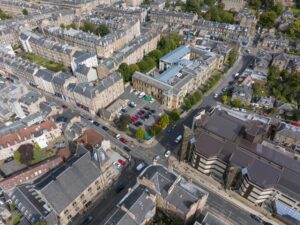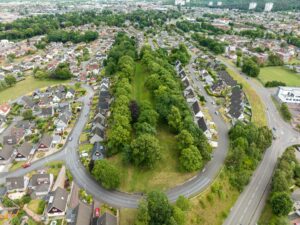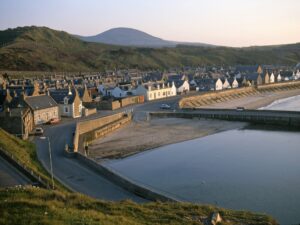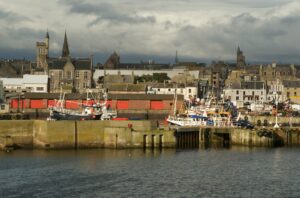What are Local Heat and Energy Efficiency Strategies (LHEES)?
Climate Change, Homeowners, Sustainability | Written by: Moses Jenkins | Friday 17 May 2024
Our Project Manager, Dr Moses Jenkins, explains what LHEES are with regards to historic and traditional buildings and why our document is important for those working with them.
The drive to reduce carbon emissions from our buildings means local authorities have been tasked with creating plans to demonstrate how they intend to take a strategic approach to meeting Scottish Government targets. These plans are known as Local Heat and Energy Efficiency Strategies (LHEES).
According to the Scottish Government, LHEES are ‘at the heart of a place-based, locally led, and tailored approach to heat transition. These local strategies will underpin an area-based approach to heat and energy efficiency planning, as well as delivery’. Historic Environment Scotland (HES) have published a document to support local authorities in delivering LHEES.

Looking toward Southside, Edinburgh. This is a neighbourhood with many traditionally constructed buildings.
What role does the historic environment play in delivering LHEES?
The historic environment is at the heart of the drive to reach net zero. The summary of existing policy and advice contained in the LHEES document will ensure that our traditional buildings and the wider historic environment are at the heart of LHEES and are treated in accordance with their heritage significance and technical requirements.
It is important to remember that the historic environment does not just refer to buildings. It also includes archaeology, gardens, and streetscapes amongst other things, all of which may be impacted by work on LHEES. Scotland’s historic environment makes our communities stronger and gives us a sense of place. It is part of our identity, and part of our future. And it is at the heart of the drive to reach net zero.

Aerial view over Dunfermline Abbey and city centre, Fife.
What does the HES summary cover?
Our LHEES document summarises sources of information useful to all those working in the creation, revision, or implementation of LHEES themselves, and the various policies which will be implemented as a result of these strategies.

A section of the Antonine Wall located amidst housing at Bantaskin, Falkirk
The document has eight sections in total, with five principal sections looking at:
- national policy and strategy for the historic environment, including the Historic Environment Policy for Scotland (HEPS), and National Planning Framework 4 (NPF4)
- identifying and defining the scope of the historic environment
- the relationship between LHEES and listed buildings
- technical guidance
- embodied carbon and the circular economy
Each section provides a short commentary on the relevant information produced by HES.
The document is very much a collaborative effort across all areas of HES. This includes integrating considerations around heritage and planning, as well as technical guidance, and considerations around embodied carbon.

View over Glasgow Necropolis and Glasgow Cathedral, towards Rottenrow.
Who should read the document?
This guidance is primarily aimed at those working in local authority planning departments. However, anyone working on decarbonisation or retrofit is likely to interact with the historic environment and may find relevant information contained within our LHEES document.
This document presents a comprehensive view of the various HES resources relevant to the decarbonisation of the historic environment. The incorporation of both technical and planning guidance is critical to ensuring a coordinated approach regarding the historic built environment.

View over Cullen village and Cullen Bay, Moray.
An important summary of existing advice
Welcoming the publication of this document, Dr David Mitchell, Director of Cultural Assets at HES, said: “This is a key part of the work being undertaken by HES to support all those working with the historic environment to decarbonise and reach net zero. This is a priority in the recently published strategy for the historic environment, Our Past, Our Future.”
Elly McCrone, Director of Heritage at HES, added: “LHEES is an important part of the way in which local authorities will approach the historic built environment across Scotland. The information contained within this document will provide a strong foundation for local authorities to take decarbonisation forward in a way that is sensitive to the needs of the historic environment.”

Fraserburgh harbour and town, Aberdeenshire.
Find out more
Read our document: Local Heat and Energy Efficiency Strategies: Historic and Traditional Buildings.
Interested in heritage planning or topics related to built heritage and conservation? Want to develop your knowledge and practice? Check our What’s On page and attend our events for heritage professionals and add to your Continued Professional Development (CPD).
Our free building advice has our latest research and best practice on traditional building materials, components, common defects and energy efficiency.
There are many misconceptions around standards for energy efficiency and how they relate to traditionally constructed buildings. Our Guide to Energy Retrofit explores the standards in detail, and gives comprehensive guidance to anyone seeking to retrofit a traditional building in Scotland.
About the author:
Moses Jenkins
Dr Moses Jenkins is a Project Manager at HES. He is the author of a number of technical advice documents, including the HES Guide to Energy Retrofit and the book Survey and Assessment of Traditionally Constructed Brickwork.
View all posts by Moses Jenkins



